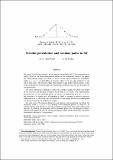Tricolor percolation and random paths in 3D
Author(s)
Yadin, Ariel; Sheffield, Scott Roger
DownloadSheffield-2014-Tricolor percolation.pdf (714.3Kb)
PUBLISHER_CC
Publisher with Creative Commons License
Creative Commons Attribution
Terms of use
Metadata
Show full item recordAbstract
We study "tricolor percolation" on the regular tessellation of R[superscript 3] by truncated octahedra, which is the three-dimensional analog of the hexagonal tiling of the plane. We independently assign one of three colors to each cell according to a probability vector p = (p1,p2,p3) and define a "tricolor edge" to be an edge incident to one cell of each color. The tricolor edges form disjoint loops and/or infinite paths. These loops and paths have been studied in the physics literature, but little has been proved mathematically.
We show that each p belongs to either the compact phase (in which the length of the tricolor loop passing through a fixed edge is a.s. finite, with exponentially decaying law) or the extended phase (in which the probability that an (n × n × n) box intersects a tricolor path of diameter at least n exceeds a positive constant, independent of n). We show that both phases are non-empty and the extended phase is a closed subset of the probability simplex.
We also survey the physics literature and discuss open questions, including the following: Does p = (1/3,1/3,1/3) belong to the extended phase? Is there a.s. an infinite tricolor path for this p? Are there infinitely many? Do they scale to Brownian motion? If p lies on the boundary of the extended phase, do the long paths have a scaling limit analogous to SLE6 in two dimensions? What can be shown for the higher dimensional analogs of this problem?
Date issued
2014-01Department
Massachusetts Institute of Technology. Department of MathematicsJournal
Electronic Journal of Probability
Publisher
Institute of Mathematical Statistics
Citation
Sheffield, Scott, and Ariel Yadin. “Tricolor Percolation and Random Paths in 3D.” Electronic Journal of Probability 19, no. 0 (January 2, 2014).
Version: Final published version
ISSN
1083-6489